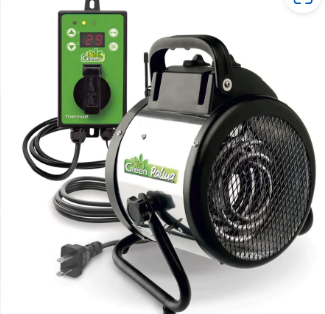
As winter's icy grip tightens, greenhouse gardeners face a significant challenge: maintaining the ideal environment for their plants. In the colder months, greenhouses must combat plummeting temperatures to keep flora thriving.
Proper heating is vital, but it need not be a costly endeavor. In this blog, we'll explore the most economical and reliable ways to heat your greenhouse during winter. From greenhouse heaters to alternative methods, we'll provide insight into why heating is essential and how greenhouse gardeners can overcome common challenges.
The Importance of Proper Heating in Winters
Why is it crucial to maintain proper heating in your greenhouse during the winter season? The answer lies in understanding the needs of your plants. Here's why:
Optimal Growth Conditions
Many plants require specific temperature ranges for growth. In winter, outdoor conditions can be too cold for plants to thrive. By heating your greenhouse, you can create the perfect environment, allowing your plants to continue growing and producing.
Disease Prevention
Proper heating can help maintain a stable and healthy environment that discourages the growth of pests and diseases. Cold and damp conditions can lead to mold, fungus, and bacterial issues, which can be mitigated with consistent warmth.
Preventing Frost Damage
Cold temperatures, especially frost, can severely damage or kill plants. By providing heat, you safeguard your plants from frostbite, ensuring they remain vigorous and vibrant.
Extended Growing Season
For those who depend on year-round gardening, heating your greenhouse allows you to extend the growing season, providing fresh produce and blooming flowers even during the coldest months.
Common Challenges in Heating Your Greenhouse
While the benefits of heating your greenhouse are clear, greenhouse gardeners often face several challenges:
Energy Costs
Maintaining a warm environment can lead to increased energy consumption, resulting in higher heating bills. Finding cost-effective heating solutions is crucial.
Temperature Control
Balancing the temperature within the greenhouse can be challenging. A sudden drop in temperature or excessive heat can stress plants or disrupt their growth.
Equipment Maintenance
Heating equipment, such as greenhouse heaters, requires regular maintenance to ensure efficient operation. Neglecting maintenance can lead to equipment failure.
Humidity Management
While heating, it's essential to manage humidity. Arid conditions can harm plants, while excessive humidity can foster mold and mildew growth.
Now, let's explore the most economical and reliable ways to heat your greenhouse during the winter season.
1. Greenhouse Heaters
MONT Greenhouse Heaters: When it comes to reliable heating solutions for greenhouses, MONT greenhouse heaters are a top choice. These heaters are designed to deliver consistent warmth to your plants while being energy-efficient. They come in various models and sizes to suit different greenhouse sizes and layouts, providing both gas and electric options. MONT greenhouse heaters are renowned for their durability and ease of use, making them a cost-effective choice for greenhouse heating.
2. Thermal Mass
Thermal mass, also known as heat sinks, refers to materials that absorb and store heat. Common thermal mass materials include water barrels, concrete blocks, and stones. During the day, these materials absorb heat from the sun or heating systems, and at night, they release this stored heat, helping to maintain a stable temperature in the greenhouse. This method can be an energy-efficient and cost-effective way to heat your greenhouse, as it reduces the need for continuous heating.
Check out our Solexx, MONT, and Riga greenhouses today.
3. Solar Heating
Utilizing solar energy to heat your greenhouse is an eco-friendly and cost-effective option. Solar heaters capture energy from the sun and convert it into heat, which is then distributed throughout the greenhouse. Solar heating systems can be integrated with existing heating systems or used as a standalone method. While they may require an initial investment, they can provide long-term energy-saving savings.
4. Insulation
Proper insulation is essential for conserving heat in your greenhouse. Insulating the walls, roof, and even the floor of your greenhouse can significantly reduce heat loss. Common insulation materials include bubble wrap, double-glazing, and polythene film. Additionally, sealing gaps and drafts in the greenhouse structure can further enhance insulation and minimize the need for additional heating.
5. Use of Thermal Curtains
Thermal curtains are designed to trap heat and maintain temperature levels within the greenhouse. They can be drawn at night or during extremely cold periods to keep the warm air inside and the cold air out. Thermal curtains can be a cost-effective solution for retaining heat and regulating temperature.
6. Alternative Heat Sources
Consider alternative heat sources, such as compost or manure piles, which generate heat as they decompose. By placing these heat sources in your greenhouse, you can harness the natural warmth they produce. While unsuitable for all greenhouse types, this method can be effective in certain situations.
7. Heat Mats and Cables
For smaller greenhouses or specific plant areas, heat mats and cables are a focused heating solution. These devices provide direct heat to plants from below, preventing frost damage and promoting root growth. They can be used in conjunction with other heating methods for targeted warmth.
8. Efficient Climate Control
Investing in a climate control system that monitors and regulates temperature, humidity, and ventilation is essential for optimizing heating efficiency. These systems ensure that your greenhouse maintains the desired conditions without unnecessary energy consumption.
9. Adequate Ventilation
Proper ventilation is crucial, especially when heating your greenhouse. It helps control temperature and humidity, preventing excessive heat buildup. Automatic roof vents and louvers can be installed to facilitate efficient ventilation, which is essential for both heating and maintaining healthy plants.
To explore a wide selection of greenhouse heaters and accessories, including Solexx 16 ft x 16 ft Conservatory Greenhouse G-316 and polycarbonate greenhouse for sale for winter use, visit our website at Mulberry Greenhouses. We provide top-quality solutions to meet your greenhouse gardening needs, ensuring your plants receive the care and warmth they deserve during the winter season.
Call us today.




